Andy Warhol Signed Soup Can – One of a Kind Conservation Treatment
Andy Warhol Signed Soup Can (Campbell’s Chicken Noodle), 1976, in the permanent collection of the Richmond Museum, City of Richmond, BC. Andy Warhol was a leading figure in the visual art movement known as “pop art”. An American artist, his works explore the relationship between artistic expression, celebrity culture and advertisement. After the success of his famed 1962 suite of paintings, “32 Campbell’s Soup Cans”, Warhol produced many works of art using the soup can image, even signing the labels of actual Campbell’s soup cans. When once asked why he chose the imagery of soup, Warhol noted, “I used to drink it. I used to have the same lunch every day for twenty years.” Combining the skills and knowledge of our paper and objects conservators, our lab has successfully conserved several of these soup cans – repairing damage, stabilizing the disparate materials, and restoring original appearance and intent.
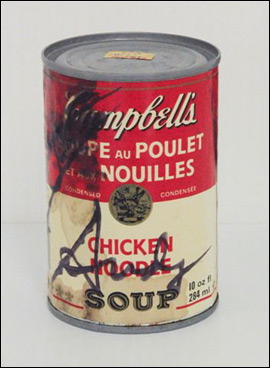 Before Treatment: In the process of natural deterioration, the soup within the can changed in composition and caused weakness, corrosion and a hole in the metal can. Through the seams and hole, liquid had seeped out onto the exterior and the label. The can was also bulging due to contained gases. The delicate label was stained with discolored liquid, rust accretions and organic material. The paper weakened and the accretions ate into the paper label causing small paper losses. The stains and accretions were disfiguring the original ink inscription. Before Treatment: In the process of natural deterioration, the soup within the can changed in composition and caused weakness, corrosion and a hole in the metal can. Through the seams and hole, liquid had seeped out onto the exterior and the label. The can was also bulging due to contained gases. The delicate label was stained with discolored liquid, rust accretions and organic material. The paper weakened and the accretions ate into the paper label causing small paper losses. The stains and accretions were disfiguring the original ink inscription. |
 After Treatment: The soup is removed and replaced with a neutral substance. The can is clean and stable, the label cleaned and restored to an appearance close to the original and the signature is again visible. Biohazards and harmful by-products, causing discoloration and deterioration, have been removed, thus extending the lifetime of the art object. The original appearance and intent have been maintained with the soup and price labels in original position and a weighty feeling to the can. After Treatment: The soup is removed and replaced with a neutral substance. The can is clean and stable, the label cleaned and restored to an appearance close to the original and the signature is again visible. Biohazards and harmful by-products, causing discoloration and deterioration, have been removed, thus extending the lifetime of the art object. The original appearance and intent have been maintained with the soup and price labels in original position and a weighty feeling to the can. |
|
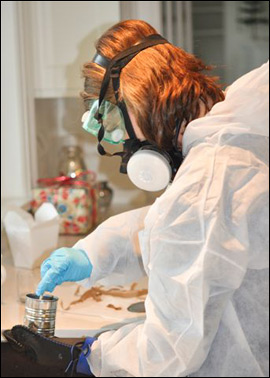 During Treatment: The can was treated by our objects conservator. It was opened using a process that left no indentations or scratches on the can. The removal of contents was carried out with appropriate safety gear. After the can was cleaned and disinfected, the conservator filled it with an inert, removable, material that provides stability to the metal over time, and mimics the weight of the original soup contents. During Treatment: The can was treated by our objects conservator. It was opened using a process that left no indentations or scratches on the can. The removal of contents was carried out with appropriate safety gear. After the can was cleaned and disinfected, the conservator filled it with an inert, removable, material that provides stability to the metal over time, and mimics the weight of the original soup contents. |
||
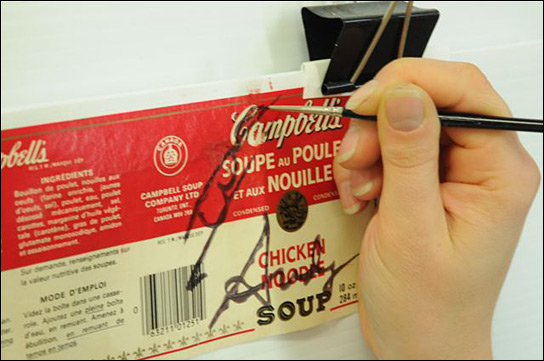 During Treatment: The paper label was safely removed from the can by softening the adhesive. Our paper conservator cleaned the label overall and locally with aqueous solutions to remove staining and chelating agents to bind and remove corrosion products. The paper was alkalized for longevity and re-sized to restore surface texture. Small paper losses were infilled with paper, and inpainted using conservation inpainting media. According to conservation ethics, this media is removable and has excellent stabilty. During Treatment: The paper label was safely removed from the can by softening the adhesive. Our paper conservator cleaned the label overall and locally with aqueous solutions to remove staining and chelating agents to bind and remove corrosion products. The paper was alkalized for longevity and re-sized to restore surface texture. Small paper losses were infilled with paper, and inpainted using conservation inpainting media. According to conservation ethics, this media is removable and has excellent stabilty. |
||
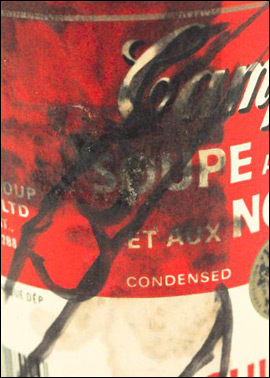 Before Treatment Detail: The label has stains, corrosion accretions as well as losses and tears due to disintegration of the paper in small areas where the stains were most damaging. Before Treatment Detail: The label has stains, corrosion accretions as well as losses and tears due to disintegration of the paper in small areas where the stains were most damaging. |
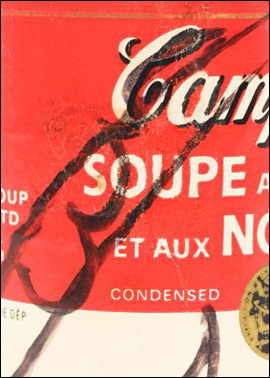 After Treatment Detail: The label is cleaned, tears repaired, losses filled and inpainted, and the paper re-sized. The exact dimensions of the label was retained in a controlled drying process, a Melinex interleaf was placed between the label and the can, and the label was affixed to the can using a conservation-sound and removable adhesive. After Treatment Detail: The label is cleaned, tears repaired, losses filled and inpainted, and the paper re-sized. The exact dimensions of the label was retained in a controlled drying process, a Melinex interleaf was placed between the label and the can, and the label was affixed to the can using a conservation-sound and removable adhesive. |
|

Leave a Reply
You must be logged in to post a comment.